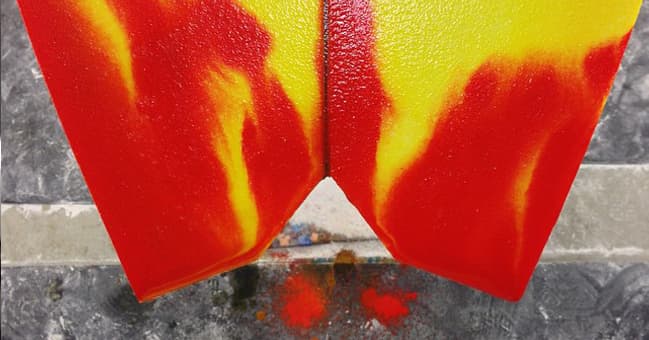Surfboard Tails, Rails and Noses
Surfboard Shapes - How noses, rails and tails effect your surfing performance
There are plenty of factors including your own performance that help determine how a board will perform. Some of the biggest factors, however, are directly related to the outline of the surfboard or surf board shape. The Nose, Rails and Tails and how they are linked together are massive in creating a good board.
While individually these elements are going to give you certain outcomes, it's how they relate to each other in combination that's really going to make a magic board or a dud.
The Nose
When it comes to determining surfboard shapes, the first third of your board is known as the nose. When we talk about nose width, we take that measurement from 12 inches down from the tip.
The shape of the nose is a key element in how the board paddles and catches waves. The wider or rounder the shape of the nose the more buoyant it is and therefore, the higher the front of your board will be in the water while you're paddling. This is due to the increased surface area in the front.
This extra surface area works really well on small wave grovellers, long boards and mid length boards that help you get onto smaller/softer waves,and help to provide stability.
The other end of the spectrum is the pointier, narrower nose that’s more commonly found on higher performance boards.
Surf board shapes with a narrower nose won’t help as much when paddling into waves – apart from when taking a late drop – it’s definitely going to help you with your performance surfing. With a pointier nose, you will get more curve in the overall rail line of your surfboard which helps you to fit into the pocket of hollower waves and helps stop you from pearling (when your nose sticks into the water) when coming out of big turns.
Duck diving is also easier with a pointier nose due to the less volume.
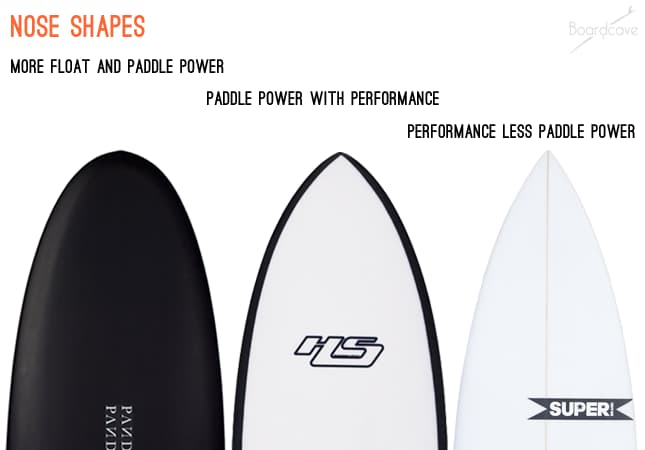
From left to right: the Panda Doinker Egg, the Hypto Krypto by Haydenshapes and the Mad Cat by SUPERBrand showing how different nose shapes effect performance.
The Rails
Since they span the length of the board (from the very top to the bottom), rails are another key part of surfboards and their performance.
There are many descriptive terms for rails, as well as an unlimited number of ways that they can be blended.
But basically, surfboard shapes are going to have either a Soft Rail or a Hard Rail. These can then also be either full or tapered.
This means you can end up with a ‘full soft rail’ a ‘tapered soft rail’ or a ‘full hard rail’ or a ‘tapered hard rail’

Canvas Surfboards' Ryan Engle working on some rails.
Surf board shapes with Soft Rails are going to perform better in smaller gutless surf conditions and on longboards, mid-range boards and blended into fish and some small wave grovellers. Usually a rounder, fuller rail with different foils.
Hard Rails, which are more commonly found on higher performance boards, have a more defined edge at a certain point around the curve of the rail towards the underside of the board.
This helps the rail to bite into the wave face and give you more hold in critical surf and helps you respond better through turns.
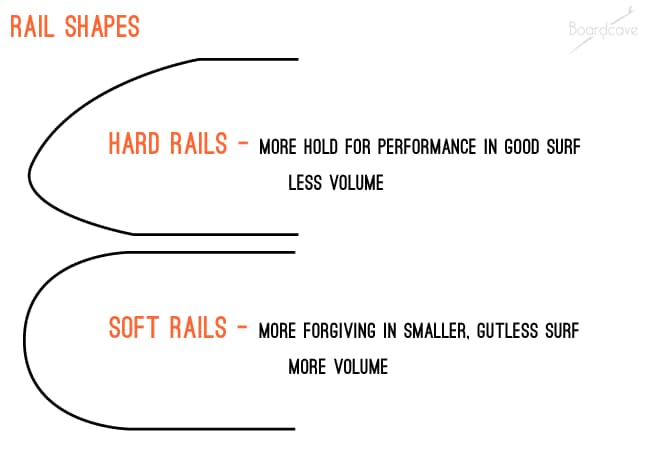
Surfboard shapes - Hard rails vs soft rails
Whether you have a hard rail or a soft rail, the more full the rail is, the more buoyancy you will get, which relates to drive and projection when coming out of turns, as well as how stable the board feels and how easy it is to paddle.
With a more tapered rail, you are able to sink it into the water more easily, which gives you a nice quick feeling coming into turns as well as surfing rail to rail. You may find though, that these rails will lack drive coming out of turns.
The tapered rails are generally less forgiving, especially when you accidentally dip your rail into the wave when you didn't mean to.
The Rail Foil
The general foil of your rail will make a difference in performance. The exact foil of your rail can be different depending on surf board shapes, however there are a few trusted foils generally used, which are 50/50, 60/40 and 80/20. This relates to where the apex of the rail is around the curve.
1. 50/50 foil is found in more soft rail options and traditionally on longboards.
2. 60/40 rail is going to be turned down with the apex slightly under the middle of the curve of the rail. This type of rail can be blended into both soft and hard rails and is also a great option on smaller wave grovelers, fish and Fun Board options. They generally give you a good blend of manoeuvrability and stability.
3. 80/20 rail is when the apex is even closer to the bottom of the board. This type of rail is generally found on surfboard shapes that incorporate a hard rail closer to the tail. These are made for easy manoeuvring and rail to rail surfing as well as performance through turns.
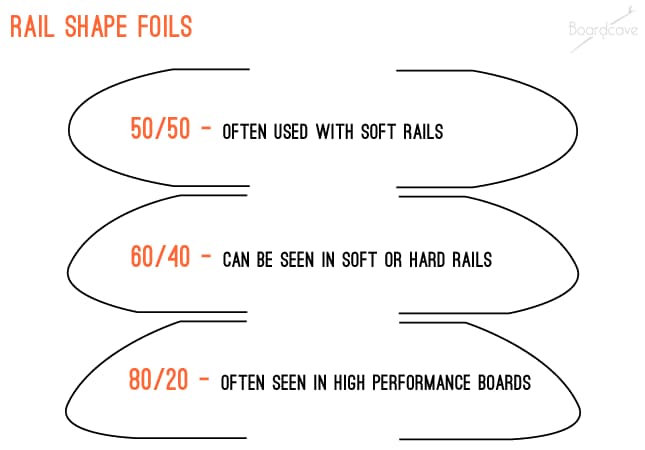
Different foils help your rail bite into the wave for better performance.
These are just some general types of rails and there are plenty of variations for each board and throughout the length of the rail of the board depending on the intentions of the shaper. The shaper also has to consider the overall length of the rail line in the water as well.
With a longer, straighter rail line you are going to get more speed in a straight line, whereas when you have a curved rail, you will increase manoeuvrability.
It is finding the happy balance of all these factors in surf board shapes that makes shaping the rail one of the most crucial elements in the shaping process.
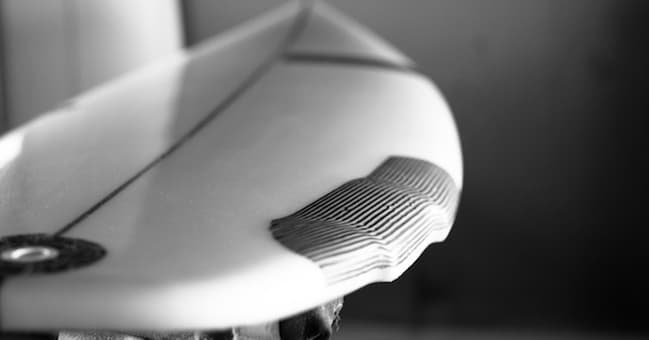
Rails and tails combining with a double wing on Chemistry Surfboards' Wide J 6 model.
The Tail
Finally, rounding out the end of the article, and the board, is the tail shape of your surfboard.
As with everything else, the exact size, shape and volume of the tail is essentially endless. But let's look at some of the basic fundamentals shapers will follow in most tails.
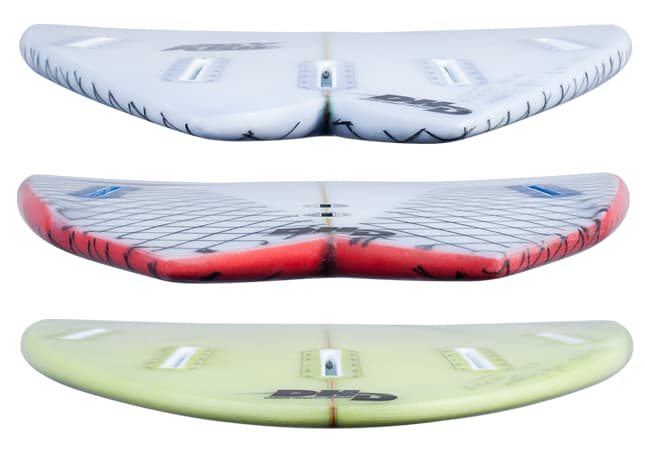
Different tail shapes from DHD Surfboards, from top down: the Joyride, the Twin Fin and the Pocket Knife.
Wider tails offer more stability and float, and will give you a faster planing speed. Narrower tails are going to make rolling from rail to rail a little easier, and can also help with your hold on a steeper faced wave.
Surfboard shapes with a tail that has rounder angles or no angles, is going to help you ‘hold’ the water for a little longer. This will translate into more control of the board.
When you get harder angles in the tail, more water will “release” and give you a looser, more snappy feel to the board. A rounder tail is better for a more open face wave with a little more size and carving potential.
In more punchy, shorter waves, a harder angled tail will help you get as many snaps as possible.
Common Tail Types
Basically there are around 5 or 6 major tail categories with an unlimited amount of variations in each, with some being blended together.
Surf board shapes mainly come with tails of these types: the squash tail, the square tail, the pin tail, the round tail, the swallow tail, and the asymmetric tail. The choice of what surfboard tail best works for you still depends on your current skill level and surf conditions.
1. Squash Tail - is the most common tail shape found on surfboards. With a squarer back end with rounded corners, you get the snappy feel of a hard-cornered square tail blended with a little more hold and release of water. They also give you that extra width which helps with slower sections of the wave.
2. Square tail - is similar in principle but with harder corners giving you a skatier feel with extra release. Great for down the line speed in smaller conditions, the hard corners act as a pivot point for turning the board. The square tail is a more traditional tail type that is less common these days as the squash tail gives a similar feel with more to it.
3. Round Tail - for slightly bigger days with open faces, surfboard shapes with round tails are a great option. With a continuous curve to help your hold on the water, you can gain more control on bigger, more hollow surf.
The round tail is a great option for open face carving with plenty of width to give more lift when outside of the critical section of a wave.

Just a few of the common tail shape types - there are also
variations on each of these.
4. Pin tail - is a staple among many step-up options and guns, where you may find yourself in the barrel or powering down the line in steeper, bigger waves. With less turning ability needed, these boards give you plenty of hold in bigger, more hollow surf.
5. Swallow Tail – gives you a wider tail for increased planing speed, the swallow tail is a great small wave board option. Don’t count this option out when it is barrelling though, it also gives you hold in steeper waves (like two pin tails) and can be a blast in steeper faced waves. Also, a ton of fun when turning on the rail. It is, however, harder to transition from rail to rail when trying to bust turns after turn.
6. Asymmetrical tail - occurs when your board has one side with a longer rail line and different shape to the other side. The idea behind the asymmetrical tail is to give you different performance dedicated to your toe side and your heel side separately.
This makes sense as you can’t perform the same way when surfing front side (toe) to backside (heel). Asymmetrical surfboards have many characteristics to them, however, looking at the tail is definitely the most obvious feature.
Your entire rail line, your foil, as well as the nose...essentially every factor of one side of the board over the other needs to be looked at for the difference in front side to back side surfing. Check out the asymmetrical tail shapes by Album Surfboards' models Fascination and the Disasym or review our Guide to Asymmetrical Surfboards.
For more information, see Surfboard Tail Shapes.
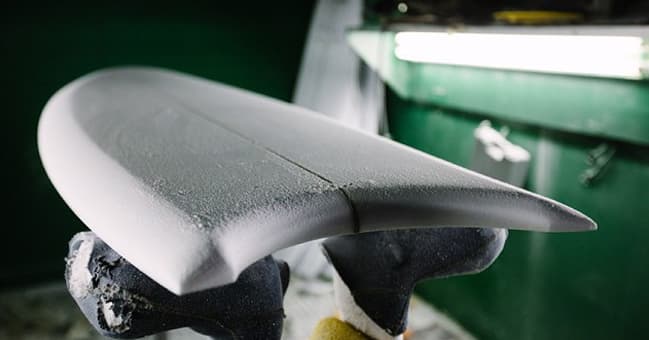
A nice little half-crest moon tail on a board in production.
The Fins
Fins come in a variety of shapes, sizes, materials, and setups. This plays a huge role in your surfboard’s behaviour regardless if you’re a beginner or pro. Fins give you control, stability, and direction. Configurations range from 1 to 5 fin setups, with single, twin, and thrusters as the most common fin configurations.
1. Single fins – this is commonly found in longboards and ideal for basic, fast, and straight shot surfing. Single fins give you better control and paired with longboards is ideal for beginners. It produces lesser drag compared to multiple fin setups. Depending on its tail placement, moving them forward gives you a looser feel or placing them further back allows for more control.
To learn more about placement and size of single fins, read our Longboard Fin Guide.
2. Twin fins – makes your boards feel more responsive and can usually be found in shortboards. They offer more manoeuvrability and allow you to skate over water. Twin fins offer better control compared to longboards especially during tight turns. When partnered with a shortboard, they also offer better speeds.
3. Thruster/Tri fin – probably the most popular fin setup, the tri-fin is perfect for surfers of all levels. The third fin provides additional stability and manoeuvrability. The two outer fins are located near the centre of the board and angled towards the board’s centre for better speed and tracking. View our selection of Thruster fins on sale.
4. Quad fin – this combines the best features of twin fins and thrusters. It offers better control and is best for small surf conditions. It offers more speed in small surf by directing water to the end of the board and out the tail for better acceleration. Similar to dual fins, they are perfect for making fast turns with the added benefit of having better control. View our selection of Quad Fins on sale.
5. 5 fin – is a surfboard board setup that allows flexibility in terms of how you could use fins. However, this does not mean that you could use 5 fins simultaneously. The surfboard comes with 5 fin boxes (insertion point for fins) giving you the option of switching from a two fin, thruster, or quad fin setup. View our selection of 5 Fins on sale.
To learn more about what fins would be best for you, check out The Definitive Surfboard Fin Guide.
Difference between surfboard shapes
Surf board shapes, including the nose shape, tail shape, and surfboard outline plays is a critical factor in determining how your board performs. There are dozens of nose, tails, length, width, and foil combinations that can be used depending on your personal preference.
Longboards – maybe one of the most iconic surfboard shapes. These boards are ideal for beginners because they offer better stability, easy to paddle, and can be used for small waves. Longboards are usually 4 to 11 feet long, have a round nose with a rounded tail pin tail or square tail.
Aside from giving you a larger surface area upfront, a round nose makes it easier to paddle into the waves and glide. It also helps you get into smaller, slower waves more easily. Square tails, on the other hand, enables you to make quick, sharp turns and can be found in high-performance surfboards.
Shortboards – became popular during the 70’s and highly recommended for intermediate to advanced surfers. These surfboards are made to give surfers maximum manoeuvrability. Shortboards feature a pointed nose and square/swallow/round tail.
A pointed nose reduces a surfboard’s lift and buoyancy. It also reduces paddling speed making it difficult to catch waves. On a positive note, it increases the surfboard's curve and the overall rail-line which increases its grip on steep wave faces. A pointed nose makes it easier to perform a duck dive and enables your nose to pop out of the water faster.
Square tails are generally good performers on most types of waves and enable you to make quick, sharp turns. Shortboards with a swallow tail work best on smaller waves. The ‘v’ cut tail shape forms two small tails which gives added ‘bite’ when weaving in and out of turns. Round tails are best for making turns with their smaller surface area making them the most manoeuvrable among the three.
Stand up paddle boards – a recent and popular addition to the family of surfboards, these surf board shapes can be enjoyed over a lake, river, or the ocean. This surfboard makes it easy for anyone to stand, hence, its name. Stand up paddle boards come with a round nose and a square tail. The round nose gives the board its lift making it easier to stand up the board. The square tail makes it possible to make quick, sharp turns.
Fish – also referred to as swallow tail surfboards, fish boards are designed for intermediate to advanced surfers looking to maximise turns on small to medium sized waves. Their pointed nose is perfect for making sharp turns while their swallow tail enables them to generate speed over small waves.
What surfboard shapes are best for you?
There is no ‘perfect surfboard.’
In your journey from beginner to becoming an intermediate or advanced surfer, one of the things you realise is the importance of using the right equipment for certain wave conditions. To maximise your surfing experience, it is not the surfer who dictates which surfboard to use but the surf conditions.
When you start learning about the different surf board shapes, you come to understand that it’s all about finding the perfect balance between the different components to achieve a desired result. For example, when you increase volume (longboards) you improve stability but suffer from poor manoeuvrability.
Basically, all these features are interrelated when it comes to surfboard design.
Every surfboard model has a different blend of these factors and there are plenty of combinations to try out. The balance and interaction between each element is going to determine how your surfboard will perform.
While there are some tried and true design elements that can be commonly found in surfboards, it is the experimenting with different blends that bring about new developments and keeps surfing fun.
Have a look at a range of surfboards or use the Board Engine to find a combination that will work best for you and don't forget to keep trying new things.
Once you have chosen your dream board, complete your surfing experience with top-notch accessories like Surfboard Racks, Surfboard Repair Kits, Surfboard Bags, and Surfboard Traction Pads. Elevate your surfing game and be fully equipped for every surf session with high-quality surfing essentials.There's much more that goes into performance and surfboard shapes. Check out our related articles that can help you understand the ins and outs to get you surfing your perfect board:
Popular Surfboards
Shop All Surfboards




